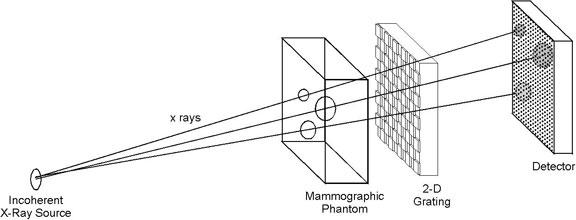X-Ray mammography based on absorption contrast is currently the primary technique for screening breast cancer. This technique results in high false positives due to the difficulty in distinguishing malignant vs normal soft tissues. A phase sensitive approach can directly measure the phase shift from these tissues, typically orders of magnitude larger than their absorption, thereby reducing false positives.
This technology uses either of two X-ray wave-front sensor techniques, Hartmann sensing and two-dimensional shear interferometry, both of which are capable of measuring the entire two-dimensional electric field, both the amplitude and the phase, with a single measurement. Capturing both the absorption and phase coefficients of the index of refraction can help to reconstruct the image. Measurement of the phase shift could enable the use of higher energy X-rays which would result in a lower amount of absorbed radiation to the patient, thereby reducing the potential damage to tissues. These wave-front sensors do not require a temporally coherent source and are therefore compatible with X-ray tubes and with laser-produced or X-pinch X-ray sources.
- Wave front sensors -> Higher sensitivity -> Directly measures cancerous tissue
- Reduces false positives -> Increases accuracy -> Earlier detection of cancers
- Use of high energy X-rays -> Allows for lower radiation doses for patients
- Medical imaging
- Non-destructive testing
- Experimental research involving X-ray wave-front sensors
Patent protection is being pursued.



